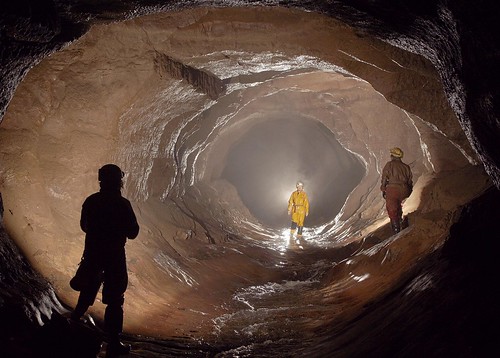As usual, a late entry to the conversation (thinking that it was probably a thread on increasing beerguts making cave s seem smaller).
Anyway - going back a bit - an example of a vadose passage being underwater can be found in Vai Nauri, Mitiaro, Cook Islands. A rise in the sea level since a previous ice age is theorised to have caused the cave to flood. Numerous underwater stals show the cave to have been dry once upon a time, and a splendid rift passage climbs up a series of 'cascades' before emerging in a pool at the base of a daylight shaft, not too far away from a lake. Theory suggests the passage was previously a vadose system carrying water from the lake to the sea...
Like Pitlamp, I am all too aware of the power of the water in submerged passages, and the mechanical erosion this can cause. In upstream Hurtle, for example, a submeged 17m deep shaft has smooth pollished ledges with obvious impact marks & scratches on them - very similar to the 'scoured' rock just inside the Goyden Entrance. I have previously laid ordinary diving line down The Void and it broke. I then tried 11mm Bluewater it broke. Next we tried one inch galvanised stell chain and that eventually broke, and more recently 11mm climbing rope (rigged as near as possible in an SRT style). This was subsequently found to have been cleanly sliced through at a point previously hanging in mid space. Two weeks ago this rope had again been sliced through in various places, and sat in a heap at the foot of the shaft....The point is, debris clearly gets washed down the shaft and causes significant impact - even though the 'weight' of the boulder is reduced by its displacement in water & thus gravity has a reduced effect compared to normal debris on the surface.
Having said that, for the many years since I started potholing I had thought of 'vadose' and 'phreatic' in the classic way. But now thinking about it...
Doesn't the water in the bottom few centimetres a metre deep stream, and the debris it carries, behave in the same way - irrespective of whether the uppermost surface of that stream is in contact with air or in contact with a rock roof? On the one hand, a rock roof might slow the flow down (drag, eddies, etc.) but equally there is marginally more pressure on the floor due to wter pressure (weight of water from the water surface....
Again the point re: cobbles or pebbles having a use as an abrasive scourer as it moves, whilst acting as a protective cover while stationary is food for thought. Similarly, would a boulder or cobble which was too big/ heavy to move cause an eddy behind it which would cause additional wear in the floor - a bit like the rim of a scallop then a deep bit caused by the eddy.
And getting down from big, scraping blocks & pebbles, what about microscopic specks of rock hitting microscopic ruggosities in the floor, walls & roof, which have already been subject of corrosion attack and are consequently easier to wear off?
All in all, perhaps for cave divers, there is more of a blur between 'phreatic' and 'vadose'.
That is, until you need to bolt for the surface in haste..... then you know what 'phreatic' really means.
Thanks again for a thought-provoking discussion, chaps.
Scoff
BPC/ CDG





